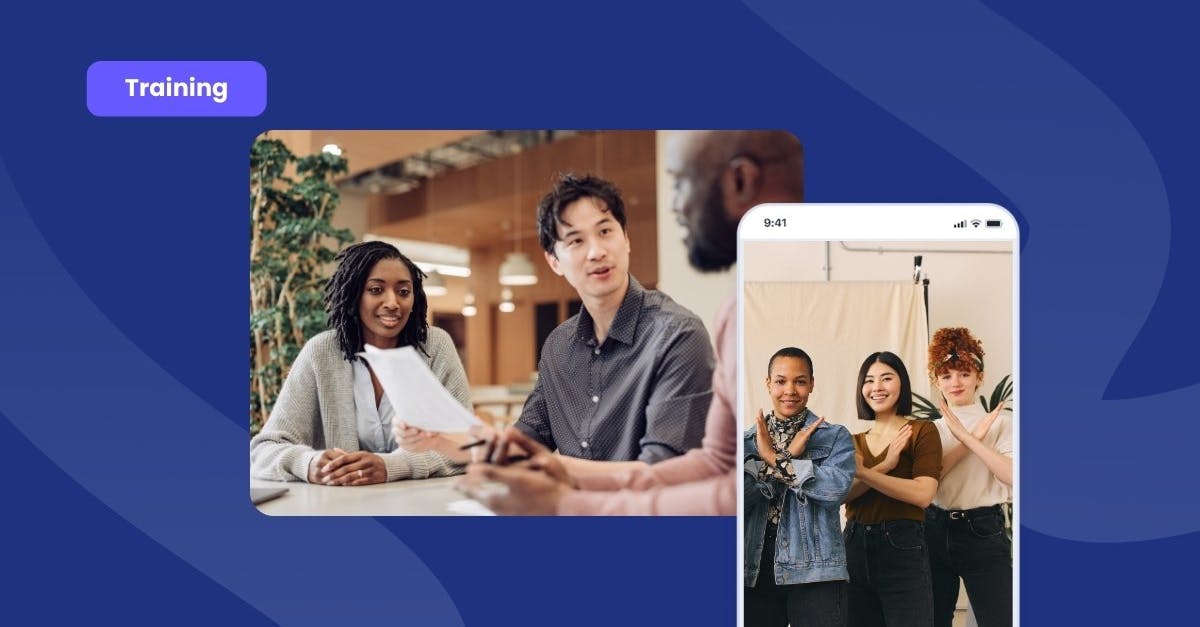10 Types of workplace bias and how to overcome them

Nurture diversity and inclusion by making the workplace a safe space. Your employees are the heart of your business, so don’t take their well-being for granted.
It’s time to foster a healthy environment where every worker can thrive—regardless of gender, race, social status, or background. To help you out, let’s explore 10 types of workplace bias and some strategies you can use to help overcome them.
What is workplace bias?
Workplace bias occurs when certain employees receive special treatment or prejudice over others. From the hiring process to task delegations and get-togethers, discrimination isn’t picky about its victim. Time and again, it’s proven to be a serious workplace problem, causing inequality and rifts between relationships.
If you don’t take active steps to reduce discrimination in your workplace, you put the company’s values and image at risk. Wouldn’t it be better for the public to see your business as fair and unbiased, rather than giving the impression of playing favorites?
The first step to addressing this is to raise awareness among your employees. If you want your workplace to thrive, it’s time to educate workers about the different types of workplace bias. Below, we’ve listed 10 popular examples, plus helpful steps to rise above them.
1. Gender bias
The first workplace bias on this list is gender bias. This happens when someone is unfairly treated simply due to their gender. Traditionally, heterosexual men benefit from preferential treatment compared to women and members of the LGBTIA+ community.
Some workers may not even be aware that their actions offend others. This is known as unconscious bias. But this doesn’t have to continue being the norm. You can introduce change through diversity and gender sensitivity training.
Luckily, SC Training (formerly EdApp) has the perfect online course to help you out. Karamo's Diversity, Equity, and Inclusion Training explores the concepts of unconscious bias, privilege, and microaggressions. It concludes with practical steps to make work a safe space for everyone.
Recommended courses:
- Karamo's Diversity, Equity, and Inclusion Training by SC Training
- What is Gender and Why Gender Equality? by SC Training
- Prevention and Response to Sexual and Gender-Based Violence by SC Training
Reduce workplace bias with diversity and sensitivity training. Sign up for SC Training today.
2. Age bias
Next is age bias. As the name suggests, this happens when co-workers discriminate against another person based on their age. This affects both older and younger generations. It’s usually revealed during the hiring process.
For instance, when choosing between applicants for a manager-level position, the higher-ups may skip employees below 40. Driven by age bias, they might believe the younger candidates are too inexperienced to lead a team. On the other hand, senior workers are victims of this when their boss forcibly asks them to retire, believing that old age stunts a person’s growth.
Unfortunately, this workplace bias is here to stay if we don’t act on it. A 2024 survey interviewing 1,000 hiring managers found that 4 in 10 were biased against Gen Z (people born from 1997-2013) candidates.
One practical step to reduce age bias among your workers is to remind them to be sensitive in their use of language. You should discourage them from making stereotypical remarks about someone’s age—whether lighthearted or not.
3. Racial bias
If you’ve got an employee who discriminates against someone based on race, then they’re guilty of racial bias. It's unlikely that people guilty of racism will admit to it. Unconscious racism is also a common scenario in workplaces. It can happen in many ways, such as through passive-aggressive remarks, exclusion from team gatherings, or unfair policies.
The way to eliminate this in the workplace is to take concrete actions against racist behavior. Hosting discussions on diversity, equity, and inclusion (DEI) is a good place to start. Make sure to include case studies and statistics in your DEI topics to emphasize the gravity of racial bias.
4. Confirmation bias
Let’s face it. Once people have formed a solid opinion over something, it likely won’t change anytime soon. Confirmation bias exists when someone favors information that aligns with their existing beliefs and belittles those that go against it. This can be harmful in the workplace, especially when making decisions that affect the lives of other co-workers.
Through cross-cultural training, you can raise awareness of unconscious bias examples in the workplace. This tackles conflict resolution, adaptation strategies, and interaction management. Encourage your workers to seek opposite perspectives with an open mind, particularly those that go against their initial beliefs. Doing so gives them a better sense of the whole picture.
5. Affinity bias
This next one is a popular bias that happens even outside work. Affinity bias is rooted in the natural desire of humans to be part of a group with similar backgrounds and interests. However, this becomes a problem when a certain person or group is unjustly excluded simply because of their different backgrounds, interests, or experiences.
Diversity training in the workplace is an effective way to resolve this. It raises your employees’ awareness of the differences between culture, religion, gender, or race. Once they’ve embraced this, you’re one step closer to creating a safe space for everyone.
6. Halo effect
The halo effect happens when we allow a single positive trait to define our perception of a person. For example, you have an employee who’s physically attractive. With this characteristic alone, others might assume that the person is trustworthy or smart—even if this hasn’t been proven.
Like all other types of bias in the workplace, this is harmful, as it clouds your employees’ judgment toward others. While everyone is entitled to their opinion, you can discourage this by reminding employees to fact-check first. Ask them to look out for strengths and weaknesses before forming a conclusive opinion over others.
7. Horns effect
Next is the horns effect, which is the opposite of the halo effect. If you’re from recruitment, this bias manifests when your perception of an applicant is wholly influenced by one negative trait. This form of stereotyping is dehumanizing as it fails to create a level playing field for all.
Spark change by establishing a thorough hiring process. You can use SC Training’s HR management system software for bias awareness and mitigation. Its diversity courses highlight that looks, gender, race, or age shouldn’t influence an applicant’s standing. These are actionable steps to making your workplace more diverse.
8. Authority bias
If you’ve ever heard of blind loyalty, this is one of its sources. Authority bias is a problem we’ve long been struggling with—not only in the workplace but also at school or home. It exists when people blindly follow someone simply because they’re in a position of authority. This may be your manager, teacher, parent, or the government.
Because they’re in higher positions, it feels natural to believe they’re trustworthy enough and incapable of making mistakes like normal people. This is true to an extent—but when it comes to the point that co-workers are forced into uncomfortable situations, it becomes a problem.
You can prevent this workplace bias by isolating the message from the authority figure. Encourage your workers to ask critical questions, reminding them it’s their right and privilege. Plus, when making decisions that affect the group, you should implement a voting system to guarantee that various perspectives are heard.
9. Conformity bias
Conformity bias occurs when people jump on the bandwagon or change their beliefs to fit in with the majority. This kind of workplace bias is especially harmful, as it strips them of critical judgment. They’re willing to discard their opinions, fearing alienation from the group.
One way to address this problem is to conduct open forums. This gives everyone a chance to voice their opinions without the pressure of being judged. Remember, as their manager, you should strive to consider various perspectives before making decisions. Ultimately, mutual respect and trust are the key pillars to nurturing an inclusive workplace environment.
10. Beauty bias
Our last type is beauty bias. This draws on the saying that looks aren’t everything. But in reality, they do play a significant role. Whether we like it or not, the world tends to be kinder to people with good looks, and the workplace is no exception.
During the hiring stage, this happens when conventionally attractive men or women receive more callbacks than their co-applicants. But if such a decision was made solely on their looks rather than their skills and experience, then there’s something wrong with the company’s policies.
Fortunately, people have become aware of this unconscious bias and are taking active steps to prevent it. In a 2024 LinkedIn poll that asked whether people should place their photos on their resumes, 91% of the 989 respondents voted no.
While you can’t control the applicants who still insist on including theirs in the resume, the least you can do is focus on their skills and relevant job experiences when shortlisting candidates.
Prevent workplace bias with SC Training
It’s time to get rid of inequality, discrimination, and favoritism. You can spark change by educating your employees against workplace bias. Luckily, we’ve found the perfect employee development tool for you.
SC Training is a mobile-first platform that uses microlearning to deliver highly targeted lessons to your team. From diversity to leadership and mental well-being, its editable course library contains over 1,000 courses to help you offer workplace discrimination training for your employees.
Initiate meaningful conversations about gender, cultural differences, and more with Discussions. Its forum-style feature lets your team interact through text, video, or image. You can use this after their digital training to check if they’ve understood the lessons. This feature helps them share their thoughts instantly, driving collaboration and knowledge retention.
Nurture a safe space for your employees with workplace bias training. Join SC Training today.
Author
Bea Maureen Cayone
Bea Maureen Cayone is a content specialist at SC Training, a leading mobile-first operations platform that provides advanced solutions for frontline training. With expertise in workforce management and workplace safety, she creates content tailored to the logistics, transportation, and energy industries. Outside of work, she enjoys reading, playing the piano, and walking her dogs.
